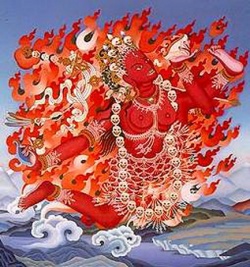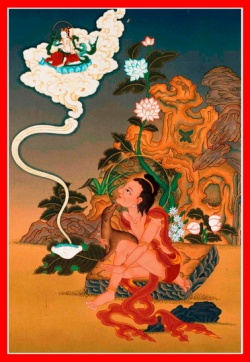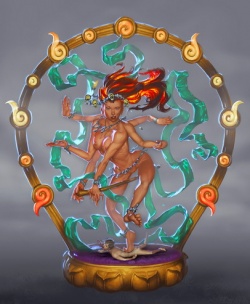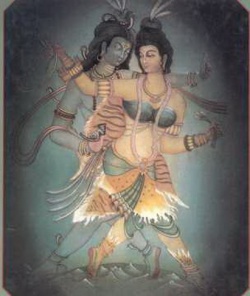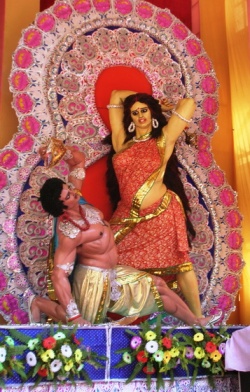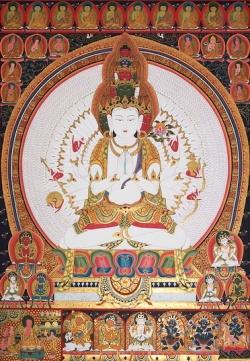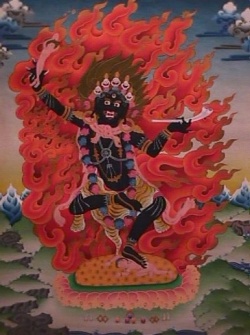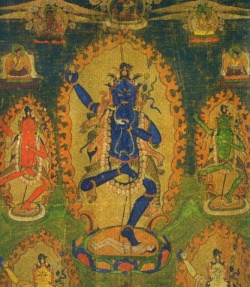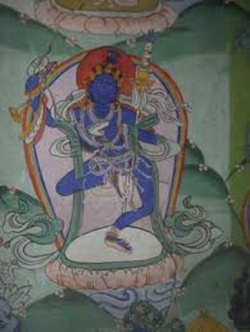The 64 Dakinis or Yoginis
From the ninth through at least the thirteenth centuries, there was an active cult of dakinis (usually called yoginis in today's India.) At least nine yogini temples have been discovered so far. The best known are the two in the state of Orissa, and the ones in Madhya Pradesh, Uttar Pradesh and Tamil Nadu.
It is generally thought that these shrines were centres for tantric practices the ultimate goal of which was the acquisition of extraordinary abilities (Skt. siddhi) or "supernatural powers." The saddhaka (practitioner) aspires to control body and mind, bring rain and otherwise regulate the elements, obtain wealth, heal the sick and perhaps also acquire destructive powers.
Some inscriptions indicate that dakini rituals were practiced well into the 16th century, but within mainstream Indian religion the cult diminished to the point that its temples were abandoned. Yet even today, offerings are often left at the feet of the images.
Some believe that the cult had origins in the animistic traditions of Adivasi (aboriginal) peoples and/or the folk traditions of grama devati (female nature deities) and that around the late 7th century, those beliefs blended with the cult of Shakti and tantrism.
Today, many students of Indian religion are familiar with some of the tantric practices associated with the worship of the Great God (Skt. Mahadeva, Tib. Lha chenpo,) Lord Shiva. For example, in the Kaula Marga (Path of Time) practice, yoginis of different categories are included in the chakra or circle of experience. When the deity is experienced in wrathful form as Bhairava, the practice is known as Bhairavi Chakra. Then the sadhana (ritual) includes the use of the 5 M's: matsya (fish,) mamsa (meat,) mudra (here referring to parched grain,) madya (alcoholic drink,) and maithuna (sexual intercourse.) For the sadhaka, the breaking of taboos extends to the jati (occupational caste) of the maithun partner; a man would seek out a Dombi (laundress) or a Madhumati (brewer) and so on.
These kinds of contravention of norms or vows seems to be a constituent of the majority of wrathful deity practices. Kali and Durga are two wrathful forms of the consort of Shiva, and worship, especially at the main shrines, includes the sacrifice of animals. This and other normally forbidden activities play a role in the worship of other, local, Indian goddesses, especially at the times of the year considered sacred to them.
However, most tantric texts use sexual references as a kind of code for something else.
Mahadeva (Tib. Lha Chenpo or Shiva -- the Auspicious,) as Buddhist deity with consort, Uma (Durga is her warrior nature.) The "Benevolent Lord of the World" is sometimes seen as an emanation of Chenresi.
One of these centres was at the Mahamaya Temple on the banks of the sacred Bhargavi river at Hirapur, 15 km. from Bhubaneshwar, Orissa. It is one of only four examples of the roofless or "hypaethral" temple that is still standing in India. (Another Orissan one is at Ranipur. The others are at Khajuraho and at Bhedaghat near Jabalpur.)
Mahamaya, the presiding deity of the Hirapur temple, is still regularly adorned with red cloth and vermilion. Mahamaya or, Great Illusion, is also a name by which the Buddha's mother is known.
Hirapur means the diamond city. The Hindi or Sanskrit name is also transliterated Heera. This is familiar to us from Greek mythology where the name, Hera, is usually taken to mean widow, despite the fact that the queen of the Olympian gods was Zeus' lawful wife and mother to Heracles.
In Minoan times (pre-1500 BCE) Hera was depicted bearing a staff and bowl similar to the attributes of Vajrayogini. On an archaic amphora, she is depicted attended by Nike, whose association with space is conveyed by means of wings. Yogini or Dakini ?
There is a distinction among the terms goddess, shakti, yogini and dakini (also, shakini) though in general conversation it is blurred and the terms are used interchangeably. Goddess is a divine being of the highest order. She is absolute in her own right. However, we do not have a term (in English) for the consort, wife or companion of a god, so we use the term goddess here, too. When the essential character and/or the activity of a god is expressed through energy or female form, the Sanskrit term shakti is more appropriate. In the Indian tradition it is most often applied to an "expression" of Shiva. In the Chandi Purana attributed to Sudramuni Sharala Das ( 15th century) of Orissa, the term yogini is used to refer to any of the many forms and/or qualities of Devi, the Supreme Goddess whose devotees are called Shaktas. Each yogini is also seen as a different part of Her body. However, in other religious texts, a yogini is an attendant of the Great Goddess. In Tibetan Buddhism, the expression meaning dakini is usually used for a female deity fulfilling the role of messenger or attendant.
Though the term yogini is also used for mysterious females who can effect extraordinary change that is ultimately, though not always apparently, beneficial, strictly speaking, a yogini is a female yogi. She is any practitioner of tantric lore in any of its variety of kinds. In legends and tales about yoginis, they are usually said to have acquired their siddhis or magical powers, such as being able to transform people into animals or birds through the mastery of some practice or more rarely, by means of a transaction with a deity or Mahasiddha.
Dakini retains the connotation, though somewhat less in the Buddhist context, of a frightening being.
In some Indian texts the word is used as a synonym for sorceress, witch or even ghoul. One of her essential qualities is the ability to fly; perhaps that is one of the reasons why temples dedicated to dakinis are open to the sky.
In Orissa, surprisingly the ancient practice of witchcraft has still survived in certain areas. ... , among the Santals of Mayurbhanj district, witchcraft is still prevalent. The Santali witches often leave behind their husbands in bed in the midst of the night to assemble in a forest. Completely naked, they spend the rest of the night dancing and singing with 'bongas' (spirits or deities) and lions as their partners. At the break of dawn, they return to their beds, back to being what they originally were. The Santals believe that the 'talent' for witchcraft is not innate, but is attained through strict discipline.
Sixty-four
In one of the religious traditions of India, there are 8 major forms of Devi, the Goddess. These are known as the Ashta Matrikas (8 Mothers.) Each of these has 8 attendants and so we arrive at the number, 64. Each of the 64 can be further correlated to the currents or winds of the human "etheric" body, or viewed as a type of neurotic or unproductive tendency (if not balanced by the others.) However, these Matrikas, or other aspects of Devi such as the fearsome Chamundas, do not appear at the Hirapur temple.
Sapta Matrikas (Seven Mothers) are frequently carved on the outer walls of the Shiva temples. (The eighth is the god's consort, in this case.) They are Brahmi, Maheshvari, Aindri, Kaumari, Vaishnavi, Varahi and Chamunda, flanked by Virabhadra and Ganesha. In a purana, Devi Mahatmyam explains how they came into being to assist the Devi in her struggle with the ashura, Raktavija. (Every drop of blood [[[rakta]]] shed by this demon turned into another weapon-wielding opponent of the Goddess'.)
Five of the six Orissan Devi temples are dedicated to the goddess as Chamunda. Here she has the form of an emaciated crone standing on a corpse. She has prominent veins and tendons, and a gaping mouth and bulging eyes. The shrine of Vaitali (or, Vetali ) is also named for her in her manifestation as a ghost or spirit. As in a 64-yogini temple, it has sculpted images on its inner walls -- in this instance there is the set of Matrikas with Chamunda-Vaitali as the main idol.
There are also two fearsome or bhairava images, one wields a knife while a severed human head lies next to him. Two other severed human heads replace the fruit offerings as found on the similar tripods of the 14 other images in the shrine. Some people interpret this imagery as an indication that human sacrifice was practiced here: the Kapalika and Kalarnukha sects that are offshoots of the Pashupatinath (Shiva as Animal Master) worship are reported to have done so.
A sixth Devi temple -- at Chaurasi, in Orissa -- is dedicated to Varahi. The rupa is of a corpulent boar-faced Varahi with curly hair. In one hand she holds a fish. Her vehicle is the buffalo.
Yogini Worship
Vidya Dehejia, who is an associate director of the Smithsonian Institute in Washington and chief curator of both the Freer and the Arthur M. Sackler Galleries, wrote a book on the subject of Yogini Temples. In 2000, she was interviewed by Vimla Patil for a Spectrum article in The Tribune (India) :
"The worship of 64 Yoginis is seen commonly between 800 and 1300 AD [sic]most of the temples dedicated to Yoginis are built in this era. The cult is influenced by Tantrik rituals and a great deal of the worship was conducted to achieve powers of black magic. The number 64, being a multiple of 8, is considered to have magical powers in the numerology of India. Devotees who performed this worship were known to conduct the Shava Chhedan ceremony — meaning the beheading of a dead body as the ultimate symbol of detachment from earthly desires. The members of this cult never harmed living beings and never conducted animal or human sacrifices.
Until 1500 AD, there are references in history to the widespread following of this cult. In the eastern provinces, there are reports that Yogini worshippers would ask for corpses from poor families with a promise of a grand funeral and provide this after their Shava or corpse ritual was over. But in later centuries, out of scary nature of the rituals and because of the growing stronghold of the Bhakti movement all over India — which preached love of god as the finest path to self realisation — this cult died a slow death, and remained only in small pockets of India. Thus, today, several Yogini temples are dilapidated and neglected with even tourists scared to enter them. Such a temple exists in Khajuraho.
However, Yogini temples in Hirakud, Ranipur Jharial and Pheraghat near Jabalpur are in excellent condition. Several of them were not even known to archaeologists till 1953. In Yogini worship, the Tantrik symbol is a chakra with 64 spokes in the wheel. Each spoke represents one Yogini a form of Shakti. In most of the well-conserved temples, the sculptures of Yoginis are intact and none of them are erotic as in other temples. This is because this cult did not believe in sex as a path to self discovery. The book I wrote on the Yogini temples has been published by the National Museum, Delhi."
In the Buddhist, Kalachakra tantric system, there is described at the navel chakra called the Wheel of Emanation, 64 channels which are the 64 goddesses of the Speech Mandala.
Lineages
Luipa, the fisher mahasiddha whose Sanskrit name is Matsyendranath, taught a system of eight chakras which was the basis for the Ka[u]la Marga tantric system. From that view, we derive the number 64 as the product of eight "petals" forming each corolla (or, pericarp) times the number of "lotuses" or chakras.
Lineages
Luipa, the fisher mahasiddha whose Sanskrit name is Matsyendranath, taught a system of eight chakras which was the basis for the Ka[u]la Marga tantric system. From that view, we derive the number 64 as the product of eight "petals" forming each corolla (or, pericarp) times the number of "lotuses" or chakras.The Kaula Marga siddhas are considered a sub-sect of Kashmiri Shaivism, but whose orientation was grouped by scholar K. C. Pandey with the Tamil Shaivas.
The 9th chapter of the Kaulajnana Nirnaya (attributed to Matsyendranath) presents the eight-chakra system, stating that the 64 yoginis are "well known in Kama-rupa." The Sanskrit expression kamarupa means desire-form, a way of referring to this reality -- the world where forms are born out of Desire. However it was also used to refer to the Indian region of Assam which Pandey called "a stronghold of Tantrism." Besides that, in the symbolic or "twilight" speech (sandhya bhasha) of the siddhas, the word also refers to the female organ and its symbol -- a trikona or triangle such as is used to depict the Muladhara or "root" chakra [of the so-called subtle body.]
By meditating on each of the 64 petals we can induce the resident yogini to grant a boon in the form of a siddhi (special ability.) The Kaula tradition teaches that in the 64-fold complex of matrices lie all the secrets of bodily perfection and also, of alchemy:
These eight goddesses stand in the field,
keeping the petals closed. Who knows why?
They won't let you see Nandi and rise up.
But you will drink the very substance of sky.
If you puff and make the eight shaktis swoon,
they'll open all the petals and go staggering off.
By using the heart of the flower,
you'll make them obey the Mother's commands.
- Bhogar. Elaayiram 7.
AND
Nandi can come here easily.
Being friendly, he will give the eight into eight:
the sixty-four.
The malleable alchemy will stand before you
with folded arms.
The deepest essence will appear explicit
and complete.
In Joy, the body becomes perfected. ~ Bhogar. Elaayiram 24.
Besides the 8 x 8 vision, there is also an Indian view of Dasha Mahavidyas: Ten Great [Ways of] Knowing "embodied" by goddesses. In other words, there are/were probably a number of dakini temples, but not all were dedicated to a company of 64.
Other Numbers
One tantric Buddhist view has Krodha Kali (Tib. Troma Nagmo) accompanied by four dakinis, so that together, they are the Wisdoms of the Five Buddha families. We can speculate that students of the Indian Mahasiddhas who systematized yogic practice came from many different philosophic and religious traditions -- orthodox, Buddhist and likely, others, too. Even, perhaps from very distant regions.
In this next Krodha Kali image [click again,] Mahasiddha Luipa is at top left holding a fish in his right hand, but on the top right is a monk who could be of the Kadampa order. The fact that Guru Padmasambhava is at the top indicates that the tangka is used by the Nyingma.
Finally, in one in which Machig Labdron is featured at the top, there are six yoginis in all.
Architecture
The temple near the village of Hirapur is the smallest of the Indian yogini/dakini temples, measuring less than 30 feet across. It is a circular enclosure of sandstone blocks on a foundation of laterites that is between 8 and 9 feet high on the exterior.
This is the only one of the "yogini" temples that has female figures on its outer walls, and their distinctive qualities lead one to conclude that this was, at least at one time, a Buddhist shrine. There are nine exterior niches, each home to a dakini sculpted in sandstone poised above large severed human heads. Each holds either her characteristic curved knife or spear in one hand, and her skull cup in the other.
There is a projecting entranceway, a feature not found in the other dakini temples. It is guarded by a pair of very wrathful, skeletal doorkeepers. Each one wears a skull garland and snake anklets. One holds a severed human head. On the pedestal are two other skeletal figures holding skull cups, each with a dog or jackal.
The short, narrow entrance is on the east and it requires the worshipper to crouch over (like a baby) to enter the sacred space which has no upper limit at all. The interior wall is about 2 meters high and contains 64 niches each with a plaque over it that identifies the female figure within. Today, only sixty figures remain.
The 64 female deities -- the Chausati (sixty-four) are variously called yoginis, dakinis, shaktis or bhairavis, are as mentioned in the Skanda Purana. Carved from a fine, black chlorite, each rupa (form) is small -- roughly a foot and a half high. Each one represents a voluptuous woman wearing a kilt or skirt held around her hips by an ornate girdle. Besides the belt, she wears the other seven symbolic ornaments: bracelets, armlets, anklets, earrings, necklace, garland and headdress. Their hairstyles include the most common one which is a cluster or bun worn to one side, or else a coronet of tight curls. Some are warriors or huntresses with bows and arrows, others balance on a pair of wheels, or play a drum. Most have two arms but a few have four.
The vahana or mount of the dakini includes animals such as the fish, parrot, turtle, frog, snake, scorpion, rat, while some appear with a decapitated male head, an archer, or other representation at their feet. Several of the dakinis have animal faces -- of a horse, ass, hare, elephant and lion.
History
It is generally accepted that the Hirapur temple was constructed sometime during the reigns of Bhauma and Somavamsi (mid-8th to mid-10th century,) since the figures resemble the style of those in the Mukteshwar temple in Bhubaneswar dating to the 9th century. That period is known as Orissa's Golden Age as a consequence of the dynasty's patronage and eclecticism in the arts, and tolerance in religious matters. However, one wonders whether it might not be on the site of a far older sanctuary.
Interesting paper by Alessandra Lopez Y Rojo on her presentation at Oxford University on 21 Feb. 2008 concerning dance and the Hirapur dakini temple.
Ranipur-Jharial Dakini Temple
This building is of sandstone and many of the figures are missing. At its heart is a Three-faced Shiva embracing Parvati. It is still a focus for worship, as Shivaratri (usually the night of the dark of the moon before springtime) is celebrated with a mela.
Jabalpur
About 28 km. from this town in Madhya Pradesh, there is another of the Chausat Yogini temples known also as the Madanpur Temple. It is one of the 25 Pithas or spots where the parts of the Goddess' body fell to earth; as such it is called Gauri Shankarji.
Here, in the fork where the Bawanganga (also called the Saraswati,) joins the Narmada River, the rock rises to a small round hillock where it commands the view of the Narmada (bewitching) River at the point where it flows through the Marble Rocks. The mandir (temple,) which is at the lower end of the gorge with its spectacular falls, is approached by a flight of 100 steps. It is a 130-ft. in diameter "cloister temple," ie. it has a separate shrine or cell for each dakini.
The spot, now called Bhera- or Bhedaghat, was earlier called Bhairavi ghat (landing) after the Terrifier, the goddess Durga. This 10th-century circular temple of the Kalchuri period (7th-13th centuries) has finely carved stone figures of the 64 deities, the names of which are given.
Legend has it that it was connected to the Gond queen, Durgavati's, palace by means of an underground passage.
"The kingdom was bravely defended by Rani Durgavati against the Mughal invasion. When she was loosing the battle, the Queen stabbed herself to death besides the consecrated banks of the Narmada. Her palace Madan Mahal and temple Chausat Jogini (The temple of Sixty Four Godesses [sic] ) are sites worth visiting. An old saying is "Madan Mahal kee chchaanv mein dhaaee laakh kee eent . . ." (Within the shadows of Madan Mahal is buried a golden brick worth Rs. 250, 000 . . .). . . . . As a tribute to the Queen, the Jabalpur University was renamed Rani Durgavati University (RDU) during mid-1980s." Khajuraho
The oldest of the surviving Khajuraho temples is the 64-yogini shrine which lies beyond the tank away from the other western group temples. Unlike all the other temples which are squared to the cardinal directions, it is oriented northeast to southwest. Only 35 of the original cells exist. The main image was the 65th, facing the entrance -- that of Kali.
Now in ruins, it is thought to date from 900 CE, but possibly even earlier. It was built on a low ridge and stands on an impressive stone jagati (platform) over 14 feet high. What little remains of the wall is also of dark granite. It is the only one entirely made of that material --- unpolished and undecorated except for some simple moldings -- and is not aligned like the others but rather northeast to southwest. Its quadrangular form is also unique. These qualities indicate its greater age than that of any of the other buildings.
It is significant, too, that it is situated more than three furlongs south of the Kandariya Mahadeva (Shiva) Temple.
The extraordinary Khajuraho site was only [re-]discovered in 1838. It consists of three groupings of temples that once numbered 85. The only one not of pink sandstone is the 64 Yogini shrine.
Varanasi
Past some of the smaller ghats (landings) such as Mansarovar Ghat, named for the holy Tibetan lake and Narada Ghat named for the legendary musician- sage, lies Chaumsathi Ghat. Here impressive stone steps lead up to the small Chaumsathi (var. 64) Yoginis. There are images of Kali and Durga, but generally the Goddess is just referred to as Ma. That is, Mother.
More About the 64
Bhogar: a 17th century Chinese potter who had come to South India to study with the Tamil siddhas and wrote "7, 000" poems that encapsulate the system.Nandi: Shiva's mount, conventionally depicted with the form of a bull.
Hera and Heracles: The ancient Greek word Hera has the meaning of a woman who is not a maid (ie. virgin) but who has no apparent husband. It is often just translated as "widow." Unattached or "uncontrolled" women were not always seen as a threat to the social order, but where they are, they risk abuse. In a UK conference concerning the empowerment of widows in the developing world, we find this item:
16. Violence against widows in the public sphere
Because widows have such low status, they are easy targets for vilification. Village leaders, police, public officials have endorsed this image of the widow as a predator, a burden, and a threat.
Many of the nicknames for widows in the vernacular, across a wide range of regions and countries are synonymous with "prostitute", "witch" (rani, raki, daken.)
Rani is queen, raki is short for rakshasi or demonness, and of course, daken is short for dakini.
The Greece-India Connection
There is no doubt concerning ancient cultural links between India and the Mediterranean. They date from over 4,000 years years ago. For example, at Tel Marduk, the remains of an ancient palace of the city of Ebla were uncovered in the 1960s. In it, a library of clay tablets gives proof that the Sumerians traded far and wide. Among the goods they dealt in was jewellery set with carnelian, turquoise, agate, lapis lazuli and amethyst, and metals such as gold, silver, copper, lead, tin and bronze. The cuneiform tablets record treaties with about 80 kingdoms from Greece to India, from the Black Sea to Egypt.
Eratosthenes (276-194 BCE) the Alexandrian geographer, mentions the place, Kanyakumari (The Virgin,) which is one of the 2 holiest spots in India -- some would say, on earth.
Another Greek, who wrote "Periplus of the Erythraean Sea," a first century CE manual for ocean travelers, says, "Those who wish to consecrate the closing part of their lives to religion come here [to Cape Comorin where the waters of three oceans meet] and bathe, and swear themselves to celibacy. This is also done by women, for it is said that a Goddess once dwelt here and bathed."
There is still a famous temple there, to Bhagavati (Lady = Hera, as Greeks sometimes give the translation for the name) Kanyakumari. At that location, Cape Comorin, sunrise and sunset can both be seen from the same vantage point, and on full-moon day sunset and moonrise can be observed together, ie. at the same time.
There once was an ashura called Bana who assisted the gods on more than one occasion. His wish not to be vulnerable "to any man" was the reward he earned for his help. However, and predictably, his demonic nature returned to him and he began to cause untold misery throughout the realms.
Bhuma Devi (Mother Earth) could not stand to witness this and petitioned the high gods to put a stop to Banashura. They could not break their word to him, so they devised his undoing in this way: They caused him to become irresistibly attracted to the virgin goddess, Kanya. However she was repelled by his advances, and when he viciously took hold of her, she killed him.
Remorseful after the killing, she performed austerities in hopes that Shiva would take notice and marry her.
Narada, the sage, determined that midnight would be the most auspicious hour for the wedding. However when Shiva’s procession reached Vazhukkumpaarai, a cock crowed, and assuming daybreak was coming and the hour was past, he returned to Suchindram. Some say that it was at the request of the gods, who wanted Kanya Devi to remain a virgin so that she would retain her power as Shakti, had the sage himself assume the form of a rooster.
The disappointed Goddess in her discouragement cursed the preparations, at which moment she turned into a statue. The sand on the beach is multi-hued -- the unconsumed wedding meats.
The rupa inside her shrine is sometimes said to have been installed by Parashurama, who threw his axe into the sea thus reclaiming the land. (His temple in Kerala is another of those rare shrines that are open to the sky.) It portrays the goddess standing, bedecked with a garland and holding her rosary in her right hand.
Legend has it that her diamond (heera) nose-jewel given by the King of the Nagas, is so brilliant that navigators miles out to sea take it for a beacon. Therefore, to prevent shipwrecks, the eastern gate of the temple has to be kept closed except for five days of the year.Nearby Kanyakumari temple is the rock, Shri Padaparai, where the Virgin retreated to do her practice and where her footprint can still be seen. It has been protected by glass and there is a meditation hall near it. (The circumstances and the spot call to mind the Greek myth of Andromeda, whose name translated is "ruler of man.")
Worship at Kanyakumari: Though definitely no longer Advaita (non-dual) in spirit, there still remains a tantric tradition at the Kumari shrine. Non-Hindus are not allowed in the inner recess, and men must remove their shirts, ie. uncover their shoulders.
"The Swami stressed ... the need for Sadhakas to diligently perform the Japa as idealised by the Goddess Kanyakumari, who stood meditatively with an Aksha (japa) Mala in her hand. Elaborating on the Kumari Tarpana Stotra, He described the playful Kumari as the Consciousness within us, traversing up the Sushumna Nadi through the different Chakras in our body and then descending as a Shower of Ambrosia/Bliss as the Sadhaka embarked on his Sadhana."
Heracles became the Romans' Her'cules. It is thought-provoking to consider that deity as if doing visualization: "Draped in the skin of a lion, wielding a club . . . ." Hercules slew the Nemean Lion, but that animal is the vehicle and symbol of the Goddess and also of a group of Indian people who worship her
